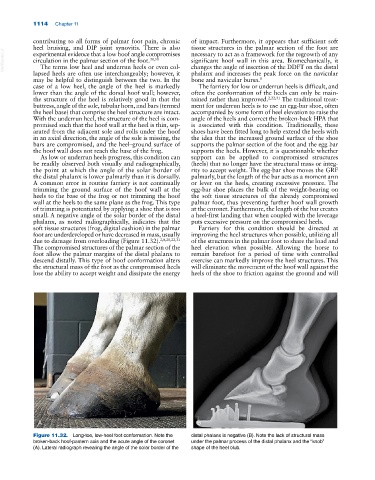Page 1148 - Adams and Stashak's Lameness in Horses, 7th Edition
P. 1148
1114 Chapter 11
contributing to all forms of palmar foot pain, chronic of impact. Furthermore, it appears that sufficient soft
heel bruising, and DIP joint synovitis. There is also tissue structures in the palmar section of the foot are
VetBooks.ir circulation in the palmar section of the foot. 38,50 significant hoof wall in this area. Biomechanically, it
necessary to act as a framework for the regrowth of any
experimental evidence that a low hoof angle compromises
The terms low heel and underrun heels or even col
changes the angle of insertion of the DDFT on the distal
lapsed heels are often use interchangeably; however, it phalanx and increases the peak force on the navicular
may be helpful to distinguish between the two. In the bone and navicular bursa. 8
case of a low heel, the angle of the heel is markedly The farriery for low or underrun heels is difficult, and
lower than the angle of the dorsal hoof wall; however, often the conformation of the heels can only be main
the structure of the heel is relatively good in that the tained rather than improved. 2,22,31 The traditional treat
buttress, angle of the sole, tubular horn, and bars (termed ment for underrun heels is to use an egg‐bar shoe, often
the heel base) that comprise the heel structure are intact. accompanied by some form of heel elevation to raise the
With the underrun heel, the structure of the heel is com angle of the heels and correct the broken‐back HPA that
promised such that the hoof wall at the heel is thin, sep is associated with this condition. Traditionally, these
arated from the adjacent sole and rolls under the hoof shoes have been fitted long to help extend the heels with
in an axial direction, the angle of the sole is missing, the the idea that the increased ground surface of the shoe
bars are compromised, and the heel–ground surface of supports the palmar section of the foot and the egg bar
the hoof wall does not reach the base of the frog. supports the heels. However, it is questionable whether
As low or underrun heels progress, this condition can support can be applied to compromised structures
be readily observed both visually and radiographically, (heels) that no longer have the structural mass or integ
the point at which the angle of the solar border of rity to accept weight. The egg‐bar shoe moves the GRF
the distal phalanx is lower palmarly than it is dorsally. palmarly, but the length of the bar acts as a moment arm
A common error in routine farriery is not continually or lever on the heels, creating excessive pressure. The
trimming the ground surface of the hoof wall at the egg‐bar shoe places the bulk of the weight‐bearing on
heels to the base of the frog or not trimming the hoof the soft tissue structures of the already compromised
wall at the heels to the same plane as the frog. This type palmar foot, thus preventing further hoof wall growth
of trimming is potentiated by applying a shoe that is too at the coronet. Furthermore, the length of the bar creates
small. A negative angle of the solar border of the distal a heel‐first landing that when coupled with the leverage
phalanx, as noted radiographically, indicates that the puts excessive pressure on the compromised heels.
soft tissue structures (frog, digital cushion) in the palmar Farriery for this condition should be directed at
foot are underdeveloped or have decreased in mass, usually improving the heel structures when possible, utilizing all
due to damage from overloading (Figure 11.32). 2,8,20,22,31 of the structures in the palmar foot to share the load and
The compromised structures of the palmar section of the heel elevation when possible. Allowing the horse to
foot allow the palmar margins of the distal phalanx to remain barefoot for a period of time with controlled
descend distally. This type of hoof conformation alters exercise can markedly improve the heel structures. This
the structural mass of the foot as the compromised heels will eliminate the movement of the hoof wall against the
lose the ability to accept weight and dissipate the energy heels of the shoe to friction against the ground and will
A B
Figure 11.32. Long‐toe, low‐heel foot conformation. Note the distal phalanx is negative (B). Note the lack of structural mass
broken‐back hoof‐pastern axis and the acute angle of the coronet under the palmar process of the distal phalanx and the “knob”
(A). Lateral radiograph revealing the angle of the solar border of the shape of the heel blub.

